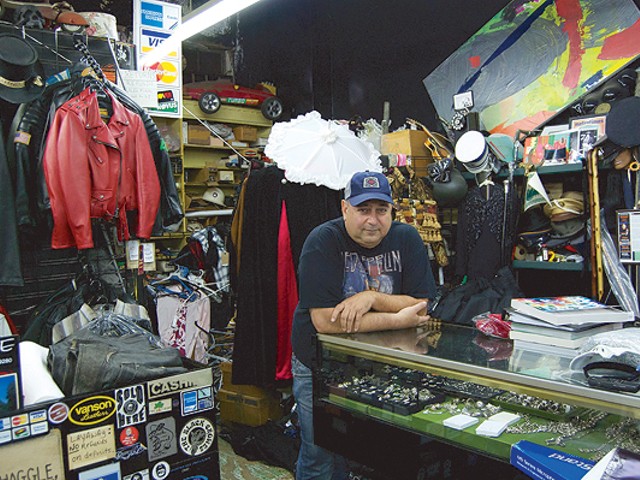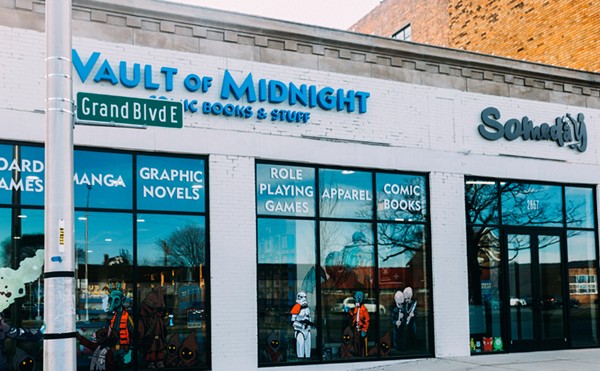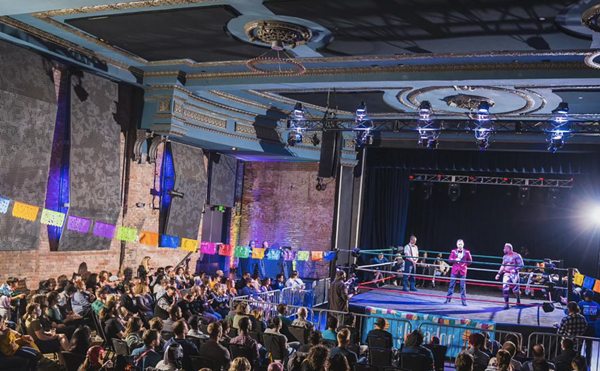It goes without saying that Detroit's Masonic Temple is a little creepy. It looms above Temple Street in a not-so-great part of town, and attached to it is a rumor or two that the place is haunted. It's nearly 90 years old and a remarkable 550,000 square feet. It has 1,037 rooms, as its staff will proudly tell you, and has hosted political figures like Richard Nixon, broadway productions like Phantom of the Opera, and musical acts like the Rolling Stones. Jack White paid off the structure's tax debt last year, and since then the Scottish Rite Cathedral has been renamed after him.
Plans for the Masonic Temple began to be laid in 1916 when Lewis Cass, Michigan's first Masonic Grand Master, starting buying up property in Cass Farms. At that time five mansions stood where the Masons hoped to build their temple. According to Steve Genther, the building's general manager, some properties were donated and some were bought for $1, but four plots were purchased, two for $25,000 and two for $30,000. George D. Mason designed the building. Albert Kahn had previously worked with Mason, but had moved on to his own work by the time ground was broken for the Masonic in 1920. In 1922 the cornerstone was laid, with the trowel that George Washington used to set the cornerstone for the Capitol Building in Washington, D.C., no less, and on Thanksgiving Day in 1926 the building was dedicated and opened for use. Despite using up the $6.5 million budget, workers were unable to finish the top three floors, but the Masons were eager to start using the massive, new facilities.
Similar to the fate of other large structures being constructed in Detroit in the late '20s, the Masonic was deeply affected by the stock market crash and ensuing Great Depression. The top three floors remain, to this day, unfinished. They include an eerie swimming pool where a partier died in the 1940s, a 12,000-square-foot theater space, and some unfinished banisters in the stairwells.
As for now, there are no plans to finish the pool or the theater, though Genther says he thinks the Red Wings arena deal might produce a developer who is interested in completing the space.
Bringing in money from the public is essential to keeping the Masonic open, though it was originally built to house and accommodate the meetings, classes, productions, and general goings-on of the Masons. When it first opened its doors in 1926, 55,000 members met inside the building at least once a week for one reason or another, and they paid dues to do so. That number has since shrunk to 3,300 members, less than half of whom pay dues. With an operating cost of $1.2 million a year, the Masonic has expanded its public events to generate the revenue that's needed to keep the building running.
"The purpose was to serve the fraternity first, then to hold events to raise money," says John R. Snider, the Masonic's resident docent.
It's to the delight of the public that more and more concerts and events are being held here. This month alone will see Theatre Bizarre, Freaky Deaky, a screening of Nosferatu, and Bastille. Next month the Masonic will hold a sold-out Bassnectar concert, as well as a Chrissie Hynde show and a Flosstradamus concert.
A handful of movies are also filmed here every year, bringing in some extra dollars. The Masonic is one of four tax-incentive-approved facilities in Michigan and the only one in Detroit. Low Winter Sun, a cop drama set in Detroit, filmed here last year, and Whitney Houston's Sparkle also used the space. Along with the approximately 30 weddings that are held at the temple every year, the historic structure manages to stay in business.
According to Snider, the Masonic's replacement value is something like $3 billion, though there's no way the building could ever be replaced, even with that kind of money.
"A lot of the stuff in this building is a lost art form," he says. "In fact, everything they put in here is a lost art form. Everything you see was carved in place."
Of the nearly 1,100 rooms, we'll admit that we didn't get to more than about 10 of them. Our tour guide led us through the Masonic Theater, a 4,400-seat auditorium that retains its original aesthetic and design. Corrado Parducci designed the magnificent light fixtures. The castings are all finely detailed, made especially for the theater. In the '90s a touring Broadway production of the Phantom of the Opera was performed here. It broke the record for the highest-grossing Broadway tour in the world. That record was eclipsed when The Lion King showed in the the same space.
Adjacent to that space is the Jack White Theater, formerly the Scottish Rite Cathedral, an auditorium adorned with wood and carvings, stained glass, and the Skinner Organ, a prize possession of the Masonic. Edward Skinner built the organ himself, which is embossed with the Double-Headed Eagle of LaGash, an important Masonic symbol. The pipes from this organ go up four floors, according to Genther.
The Masonic has four other pipe organs. It has seven stained-glass windows, but none of them are registered to the Michigan Stained Glass Registry because they aren't visible from the outside. There are seven lodge rooms, all of which are done in a different architectural style. There are 16 above-ground floors, though some rooms are three- to four-stories high. There's a floor midway between the upper and lower levels, and there are two levels below that. There is a drill hall, two ballrooms, a dining hall, a couple of kitchens, and several parlors and lounge rooms.
The Masonic Temple was named to the National Historic Registry in 1980. It's a beautiful maze of spaces, entirely adorned with emblems, symbols, and art that reflect the ideologies and beliefs of the Freemasons.





